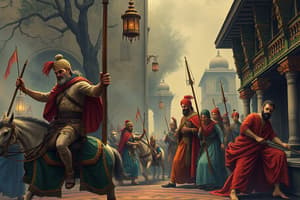Podcast
Questions and Answers
What event marked the beginning of the First War of Indian Independence in 1857?
What event marked the beginning of the First War of Indian Independence in 1857?
- The spread of discontent among civilians in India
- The revolt in Meerut led by Mangal Pandey
- The introduction of new Enfield rifles to Indian soldiers (correct)
- The disrespect of Hindu traditions by the British
What were the perceived contents of the greased paper cartridges that caused offense to both Hindus and Muslims?
What were the perceived contents of the greased paper cartridges that caused offense to both Hindus and Muslims?
- Vegetable oil
- Ghee (clarified butter)
- Cow fat or pig lard (correct)
- Alcohol
Who led the revolt in Meerut, which sparked a series of rebellions across northern India?
Who led the revolt in Meerut, which sparked a series of rebellions across northern India?
- Rani Lakshmibai
- Tantia Topi
- Nana Sahib Peshwa
- Mangal Pandey (correct)
What were some of the factors that contributed to the spread of the rebellion in India?
What were some of the factors that contributed to the spread of the rebellion in India?
Where did pivotal battles take place during the First War of Indian Independence?
Where did pivotal battles take place during the First War of Indian Independence?
Which two leaders played crucial roles in organizing the rebellion during the First War of Indian Independence?
Which two leaders played crucial roles in organizing the rebellion during the First War of Indian Independence?
What was the main impact of the First War of Indian Independence on nationalist sentiment in India?
What was the main impact of the First War of Indian Independence on nationalist sentiment in India?
What was the lesson learned from the First War of Indian Independence regarding united opposition?
What was the lesson learned from the First War of Indian Independence regarding united opposition?
What measure did the British enact following the suppression of the mutiny to improve representation?
What measure did the British enact following the suppression of the mutiny to improve representation?
What did Mahatma Gandhi emphasize as a key lesson learned from the First War of Indian Independence?
What did Mahatma Gandhi emphasize as a key lesson learned from the First War of Indian Independence?
What area continued to show resistance against British control until November after the mutiny was suppressed?
What area continued to show resistance against British control until November after the mutiny was suppressed?
Which act brought sweeping changes in governance and security measures after the First War of Indian Independence?
Which act brought sweeping changes in governance and security measures after the First War of Indian Independence?
Flashcards are hidden until you start studying
Study Notes
History & Civics: The First War of Independence (1857)
The year 1857 marked the beginning of one of India's most significant uprisings against British rule—the First War of Indian Independence, also known as the Sepoy Mutiny. This conflict spanned from May until early September of 1857, with its roots grounded in complex political, social, economic, and religious factors.
Origins and Motivations
Conflict emerged when sepoys (Indian soldiers serving under the East India Company), angered by their perceived humiliation, disrespected Hindu traditions during drill training with new Enfield rifles. Upon biting greased paper cartridges used with these weapons, the oil contained was rumored to contain cow fat or pig lard, offending Hindus and Muslims alike. Additionally, military policies introduced by the British were seen as exploitative and degrading to native Indians.
Sepoys revolted in Meerut, led by Mangal Pandey, sparking a series of rebellions across northern India. Though initially localized, the insurrection soon spread due to discontentment among both civilians and soldiers regarding taxation, land reforms, and social restrictions imposed by British colonialism.
Particular Battlegrounds
Pivotal battles took place in Delhi, Lucknow, Kanpur, and Arrah, where rebel forces were either defeated or forced into submission. Two prominent leaders, Nana Sahib Peshwa and Tantia Topi, played crucial roles in organizing the rebellion. By July, British troops regained control over much of the region; however, resistance persisted in remote areas such as Bareilly and Gwalior until November.
Aftermath and Legacy
Following the suppression of the mutiny, the British enacted sweeping changes in governance and security measures via the Indian Councils Act, improving representation while curtailing the independence of local rulers. Despite this apparent reversal of fortune, the rebellion contributed to increased nationalist sentiment throughout India, paving the way for future freedom movements.
Lessons Learned
Though the separatists did not achieve immediate victory, the First War of Indian Independence established key principles that would shape the foundation of future struggles against colonization. In particular, it illustrated the importance of united opposition, demonstrating how diverse factions could work together towards common goals despite differences in ideology, religion, and ethnicity. It highlighted the need to address underlying grievances rather than merely suppress dissent through force. As Mahatma Gandhi later observed, "First came the sepoy mutiny...Then followed the Swadeshi movement, home rule agitation, noncooperation and civil disobedience campaign." These events culminated eventually in India's attainment of sovereignty.
Studying That Suits You
Use AI to generate personalized quizzes and flashcards to suit your learning preferences.




